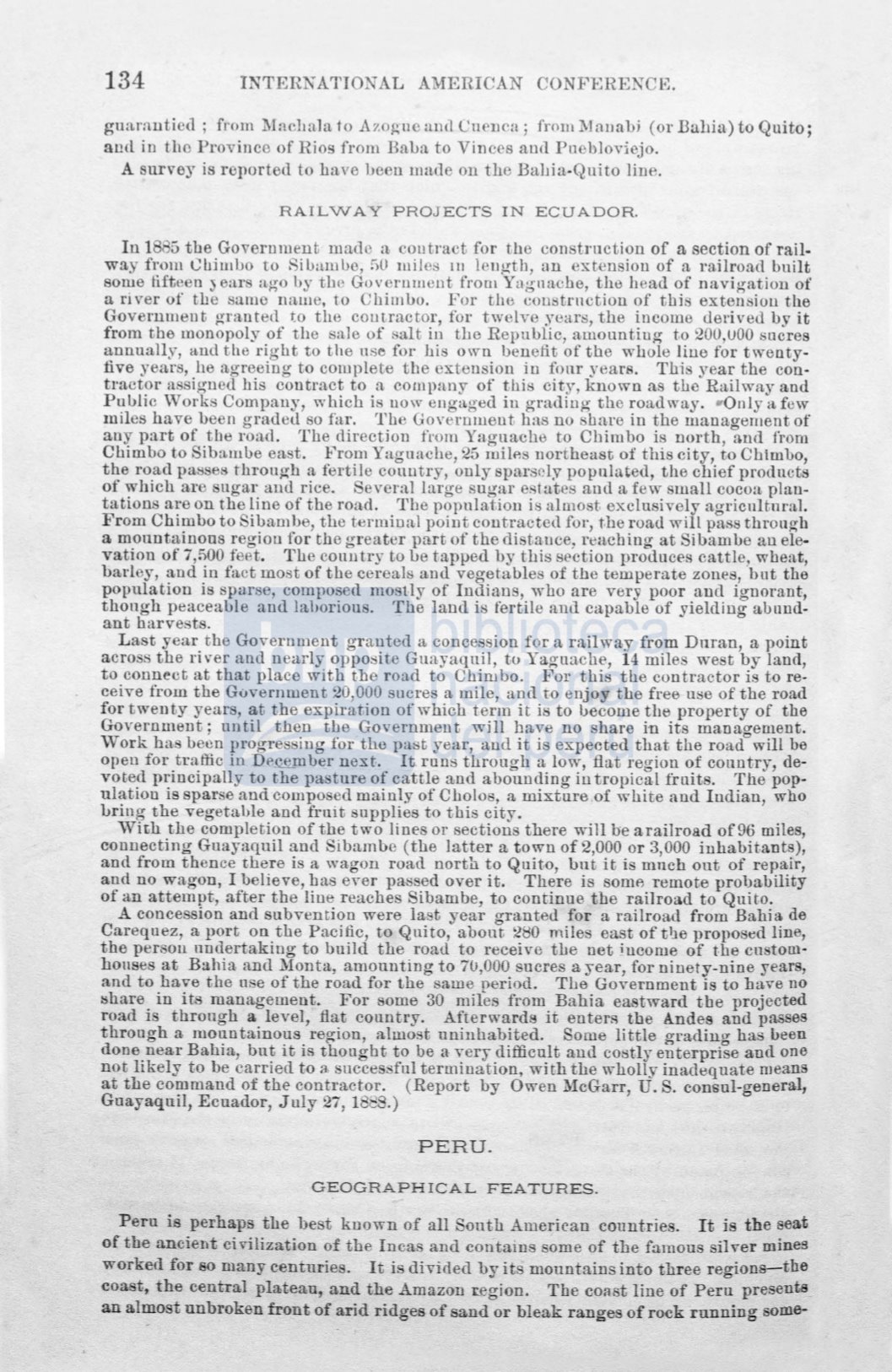

134
INTERNATJONAL AMERICAN CONFERENCE.
guamutied ; from Mn hala to .A1.ogne and Cnenca; from M:mabi (or Babia) to Quito;
and in tbc Province of Ríos from Baba to Vinces anü Pu bloviejo.
A survey is reported to have heen made on the Bahia-Quito line.
RAILVVAY PROJECTS IN ECUADOR.
Iu
1
,
5 tbe Government made a coutract for the constrnction of a section of rail–
way from Cuimbo to , il>amuo, !)0 wiles
111
leu~th,
an e:s:ten ion of a railmad built
sorne lifteeu
~
ears ago by tbe Governmont from Yngnache, the head of navigation of
a river of tbe same name, to Cbimbo. For the con trnction of this extensiou the
Government granted to the coutraotor, for twelve years, the income derived by it
from tbe monopoly of the sale of -alt in tbe Republic, aruounting to 20U,u00 sacres
annually, and the ri rrht to the uso for bis own benefit of the whole Jiue for twenty–
five years, he agreeing to complete the extension in fonr years. This year the con–
tractor a signed bis contract to a cornpany of tllis city, known as the Railway and
Public Works Compauy, which i uow engaged iu grading the roadway. •Only a few
miles have been graded so far.
'l'he Government has no share in the management of
any part of tbe road. The direction frorn Ya.guaclle to Chimbo is north, and from
Cbimbo t.o Sibambe east.
:F'rom Yaguache, 25 ruilfls northeast of this city, toChimbo,
the road pas e¡; tbrough a fertile conutry, only sparscly popnla.ted, the cbief products
of whicb are ugar anu rice. Sevcral large sugar estates anda few small cocoa plan–
tations are on the line of the road. The population is almost exclusively agricnltnml.
From Chimboto ibambe, the terminal point contracted fot·,
t.
be road will pass through
a mountainous regiou for tbe greater part of the dista u
ce~
reaching at Si bambe au ele–
vation of 7,il00 feAt. The couutry to be tapped by tbis section prounces cattle, wheat,
barley, and in fact mo-·t of tbe cereals and vegetables of the temperate zones, but the
population is sparse, composed mostly of Indians, who are very poor and ignorant,
thongh peaceable and lahorions. The land is fertile and capable of yielding abnnd–
ant harvest .
Last year the Government granted a conce sion for a railway from Duran, a point
acro
the ri \"er and nearly oppo 'ite Guayaquil, to Yaguache, 14 miles west by land,
to connect at that place with the road to Chiru bo. For this tbe contractor is to re–
ceive from the Gúvernruent 20,000 suet-es a mile, and to enjoy the free use of the road
for twenty years, at the expirat.ion ofwhich term it is to I.Jecome the property of the
Government; ontil then tbe Government will have no share in its management.
\Vork ha becn progres ·iug for tho past year, and it is e:s:pected that the road will be
open for traffic in De.QWlber ne:s:t.
It rnns throngh a low, flat region of country, de–
voted principally to the pasture of cu.ttle and abounding in tropical frnits. The pop–
ulation is spar ·e and compo ed mainly of Cholo , a mixture .of white and ludian, who
bring the vegetable and fruit upplies to this city.
\Vith the completion ofthe two lines or sections there
will
be arailroad of96 miles,
connecting Guayaquil and
ibambe (the latter a town of2,000 or 3,000 inbabitants),
and froro thence there is a wagon road north to Quito, bnt it i mnch out of repair,
and no wagon, I believe, has ever pas ed over it. There is sorne remote probability
of an attempt, after the line r eaches Siba.mbe, to continue tbe railroad to Quito.
A conce sion and subvention were la t year granted for a railroad from Bahia de
Careqnez, a port on the Pacific, to Quito, about)! O mile east ofti:Je propostJd line,
the per. on nndertakiug to bnild the road to receive the net incorne of the cu tom·
bouses at Bahia and Monta, amounting to 7ú,OOO sncres ayear, for ninety-ni
ne years,
and to bave the use of the road for the same period. T!Je Government is to
ha.veno
:;hare in its managemen
t. For sorne 30 miles from Babia eastward the p
rojected
road i
through a level,
fl.atcountry. Afterwards it enters the Andes and pa-sses
through a mountainous
region, alwost uniubabited. Sorne little grading has ueen
done near Babia, bnt it is thougbt to be a very difficnlt and costly enterpri e and one
not likely to be carried toa,
succes~ful
termination, with the wholly inadequate means
at the command of the contractor.
(Report by Owen McGarr,
U.
S. consul-general,
Guayaquil, Ecnador, July 27, 181:38.)
PERU.
GEOGRAPHICAL FEATURES.
Peru is perhaps the be t known of
all
outh American countries.
It
is tbe seat
of the ancient civilization of tbe Inca and contam
ome of tbe famons sil ver mines
workefl for so many centnrie .
lt
is divided by it mountains into three regions-the
coa t, the central platean, and the Amazon 1:.egion. Tbe coast line of Peru presents
an almo
t
unbroken front of arid ridges of sand or bleak ranges of roek running ome-
















